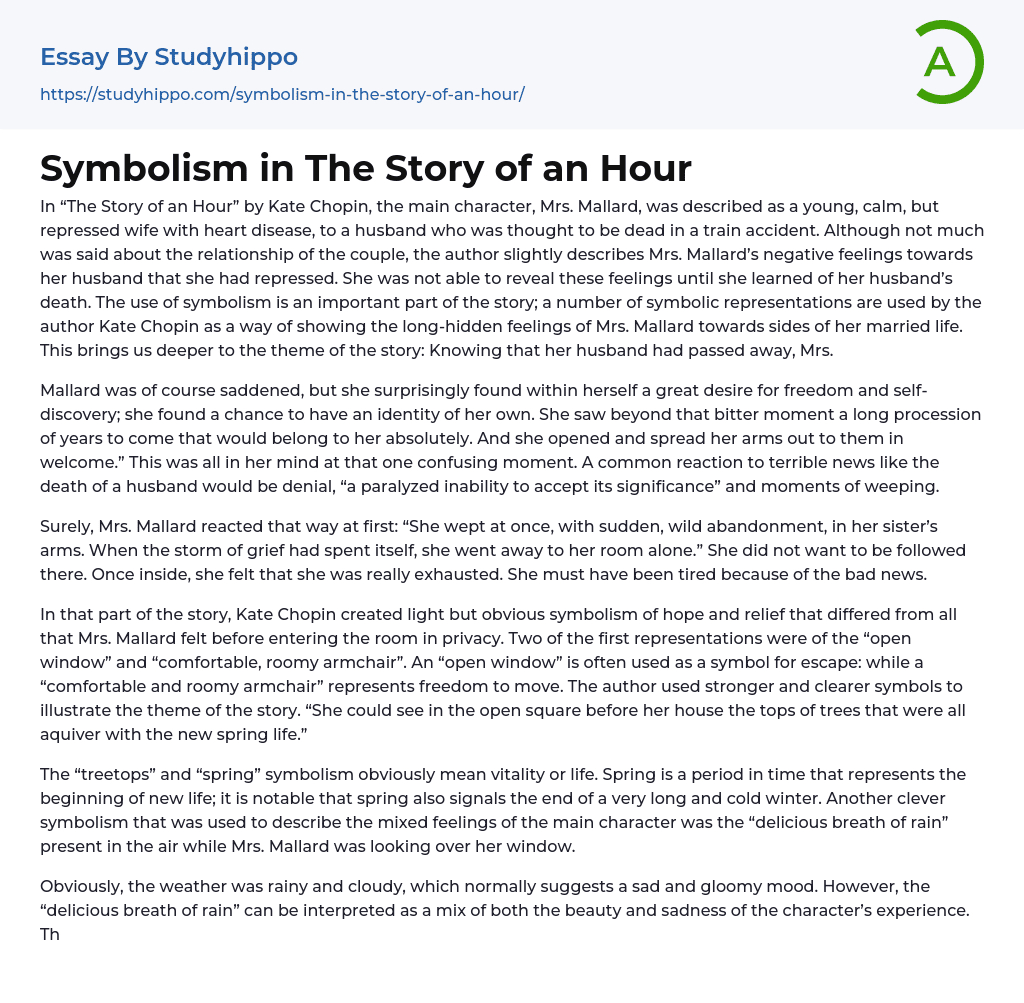“Knowing that he was killed,” thought the wife, “and then a feeling of joy went over her.”

Image: studyhippo.com
A tale of liberation and constraint
Kate Chopin’s “The Story of an Hour” paints a vivid picture of the stifling nature of 19th-century marriage customs, in the light of an unforeseen moment of jubilant freedom. When Mrs. Mallard receives news that her husband has died, she initially feels a profound sense of grief, the uncontrollable crying is a reflection of the patriarchal society that had subjugated her being. But, as time proceeds, a resurgence of hope and vivacity find its way, a joy stemming from her newfound liberation. However, just as speedily as Mrs. Mallard has an epiphany about her freedom, she comes crashing down with the shocking news that her husband was not dead after all. The news crushes her newfound hope, resulting in her tragic death, due to an ““joy that kills.”
The deeper meanings prevailing
Just like Mrs. Mallard, who initially feels great pain due to her sudden solitude, many women in the 21st century are overcoming to assert themselves and stand up for their rights and fundamentals. In countless societies across the world, women are rendered second-class citizens, unable to attain education, possess assets, and express themselves on equal terms with their male counterparts. Similarly, young ladies seldom have the scope to expand their knowledge spectrum beyond the four walls of their houses. Yet, just like Mrs. Mallard’s short-lived liberation, these women are resilient and tenacious, eternally straining towards progress, even if constrained by their environments.
In Chopin’s era, it was usual for women to wed and fall into what was perceived as “natural” domestic roles. Nevertheless, beneath the veil of normality and propriety, many women stifled their desires while struggling to find fulfillment within the limitations of their homes.
The paradox lies in how Mrs. Mallard grieves for the death of her husband: “there would be no one to live for during the coming years.” In her desolation, she focuses on the realization that she can henceforth shape her own life. She can cultivate her hobbies, pursue her aspirations and, well, basically “live” for herself and not solely for her spouse.
Her mentality becomes that of a ‘free soul’, where individuality and independence become paramount. She yearns to explore the world out there, unlimited, and liberated from the constraints of a conventional relationship. Just as the oncoming spring across the world breathes vibrancy into nature, Mrs. Mallard feels revitalized, ready to break free of societal limitations or gender norms that had formerly cornered her.
The “waves” in the novella can be interpreted as metaphoric of the paradoxical liberation and constraint. On the one hand, they symbolize the excitement that Mrs. Mallard feels when she discovers her new freedom, preparing to embark on the voyage of self-discovery. But alternately, these very “waves” can represent the contentious nature and strong societal norms that were foreboding and suffocating for so many women in the 19th century.
Mrs. Mallard’s unusual cardiac complication can be seen as suggestive of her unanticipated death, mirroring societal constraints on women’s autonomy and desire to shape their future as per their unique wishes and not society’s conventions.
Chopin’s intent to illustrate the stifling domestic settings and established gender norms is spotlighted in the account of Mrs. Mallard’s marginal existence and subsequent death, portraying how traditional marital strictures can squash aspirations, erase individuality, and shatter free spirits.
Hence, “The Story of an Hour” remains a powerful work of feminist literature, shedding light on conventional marriage dynamics of the 19th century. Even in our modern times, the central theme of emerging personal identities juxtaposed against confining norms is apparent with people fighting against social constraints and oppression, both mental and social.

Image: www.coursehero.com
The Story Of An Hour Symbolism
FAQs on the symbolism and irony in “The story of an hour”
Q: Who is “free bird” that Louis refers to in his excitement about telling the news of Brently’s death?
A: Ironically, the “free bird” is Mrs. Mallard, who is filled with a sudden sense of liberation. From the beginning she reverts to just Mrs. Mallard, not the entitled, Mrs. Brently Mallard.
Q: What are the literary devices utilized to reflect Mrs. Mallard’s grief as well as exhilaration?
A: Irony and symbolism are effectively woven into the story, with meaningful imageries like the “waves” echoing Mrs. Mallard’s inner battles, adding symbolic structure to the story.
Q: Why do you suppose critics have conflicting views and interpretations of “The Story of an Hour”?
A: The beauty of well-crafted literature is in the variance of interpretations that it can encapsulate. At the tale’s surface, it may appear a feminist statement of liberation, yet others could perceive undertones of suppression and inability to break norms.
Q: Where might Mrs. Mallard have gone if she hadn’t collapsed when her husband “came back to life”?
A: An interpretation of where she could have gone can prolong audiences’ thoughts on the story, however, creating speculative scenarios run contrary to the story’s purpose.
In summation, “The Story of an Hour” stands as an enduring thematic symphony of liberation and censure, a tragedy of unfulfilled hopes and dreams. Yet, it showcases a woman’s spirit, the echoes of which ring through generations, resonating with anyone who has ever ached for freedom and connection. Is this a narrative that captivates your thoughts? Let us continue the dialogue.